Welcome to the enchanting Sorrento, its history, its unique setting, its art crafts and its fragrances and flavors
The siren of the Amalfi Coast, Sorrento, calls and invites you to explore its many attractions
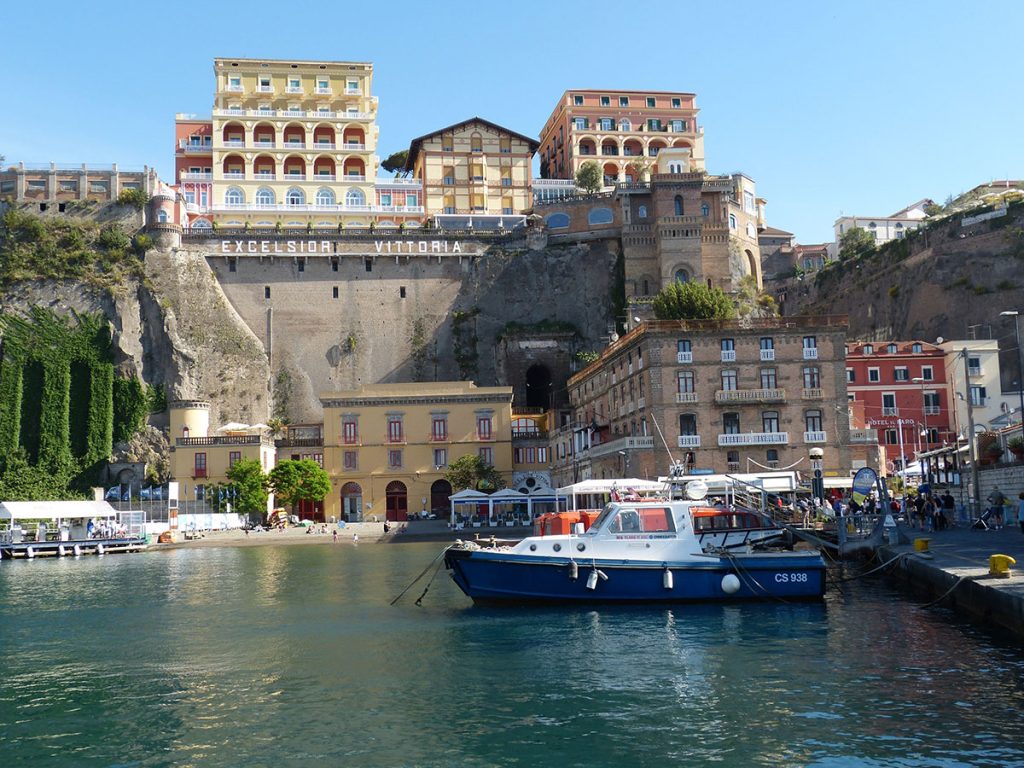
Sorrento is a small town in the province of Naples surrounded by a wide amphitheater basin on the gulf and sits on a majestic and high ridge of tuff with the profile of Monti Lattari enclosing the picture. It is considered one of the most beautiful places in the world and its jagged coast is made up of caves and coves which can be discovered by boat.
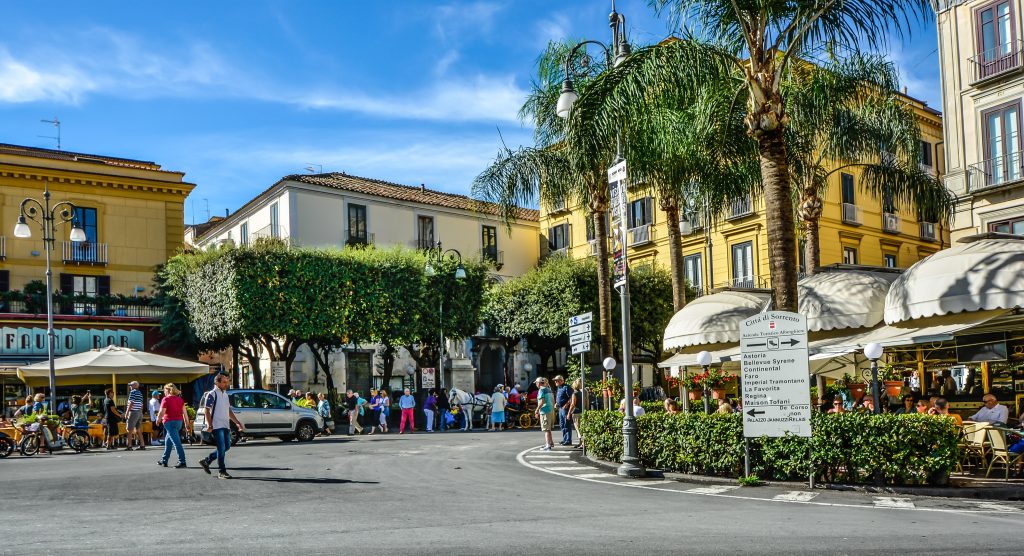
Sorrento’s reticular city plant, this is still evident in the historical center, shows a city crossed by a series of longitudinal and transverse streets about three meters wide (decumani and cardinals, according to the Romans) as in the area of Decumano Maggiore in via San Cesareo and the main hinge leading to the Greek door that is still in place. Evocative is the walk from the Greek door to the fishing village of Marina Grande. On this Marina the “Gozzo Sorrentino”, the typical goiter boat of Sorrento, was created by the hands of the first shipwrights hundreds of years ago.
The past history of Sorrento was characterized by many influences; the incursions of the Saracens, the time of the free Duchy of the IX sec. and the illustrious men that visited Sorrento between the middle of 1700 and the end of 1800, for example the German author Goethe, the poets Byron and Shelly, the composer Wagner and the playwright Ibsen. One for all, the Italian epic poet of ‘500 Torquato Tasso who was born here and is known for masterpiece is the “Jerusalem Delivered”. The famous building called Sedile Dominova, dated back to the Gothic Age, was used as a meeting place for the public life of Sorrento as part of the nobility used to gather there and it is one more step back in time and in Sorrento’s history.
The natural setting of Sorrento is influenced by the different altitudes and climate that create the ideal habitat for a transition from chestnut trees to walnut trees to the many kinds of citrus fruits, such as oranges and lemons.Citruses and fresh produce are heavily present in the Sorrentine gastronomy, allowing a wide range of local delicacies: the very famous limoncello, dairy products such as Provolone del Monaco and Caciocavallo, then DOP extra virgin olive oil (protected designation of origin) to the pastry delights made according to ancient recipes handed down with love. For this reason, it is a good idea to enjoy in Sorrento a nice relaxing break at the municipal citrus orchard: in the shade of pergolas, visitors are offered natural elixirs extracted from the fragrances of citrus fruits.
We have talked about Sorrento’s history, natural setting and food. Sorrento also offers a strong tradition in its artisanal works, marquetry is a technique still widely used, where the inlaid of wood began in the nineteenth century and this can be easily seen while walking along the streets of the historical center, where it is possible to stop in the artisan stores and admire the phases of wood working according to the traditional practice. Wonderful opportunities to see it close are the permanent exhibition of inlay located in the fourteenth-century Cloister of San Francesco (a palace that is a masterpiece of Moorish art) , the Museo Bottega della Tarsia Lignea and the Sorrento inlays section of the Correale di Terranova Museum.
Being in Sorrento will both take you back in time and will surprise you with the beauty of the present. You will feel as if the great musical repertoire dedicated to Sorrento speaks to you: songs like “Torna a Surriento” ( Come back to Sorrento) and Lucio Dalla’ “Caruso” are just expressing the same emotion you feel, that Sorrento is unforgettable.
Amalfi Coast
A journey along the Amalfi Coast to visit its main and most renowned sites: Positano, Praiano,the Emerald Cave, Amalfi, Ravello, Cetara and Vietri sul Mare
Watchtowers, hiking trails, lemons, beaches, good food, sfogliate, villas and even anchovies: these are just some of the things you will experience in a tour around the Amalfi Coast
The Amalfi Coast, one of the most prestigious tourist, cultural and environmental sites in Campania and enlisted as World Heritage by UNESCO is made of that trait of Campania region’s coast between Sorrento and Vietri sul Mare, a series of villages overlooking the blue sea and islands kissed by the sun.
Once you take the SS 163 road which connects the Amalfi Coast major towns, you will enjoy a 50 km long stretch of road characterized by a series of tight curves and hairpin bends overlooking the sea and you will experience one of the most scenic road in Italy, both with steep slopes and endless breathtaking landscape views of the Gulf of Salerno. While driving you may take the chance of stopping in one of the many lay-bys and admire the view and take in the infinity of the sea, the Lattari mountains and the vegetation of the Mediterranean scrub showing themselves as part of the Regional Park. The coast is dotted with a dense network of coastal watchtowers used once to control the arrival of Saracen ships: the tower Fornillo, the tower Asciola in Praiano, the tower of the Cape of Conca dei Marini, that of Ziro between Amalfi and Scala.
There are not many places in the world where peaks of 1400 m. are so close to the sea. The phenomenon can be appreciated by taking a hiking trail, the “Path of the Gods”, one of the most popular routes for tourists from all over the world. The amazing factor is that only a couple of kilometers separate the peaks from the coast. Offshore there are some small limestone islands, the well-known islets “Li Galli”, known as “Sirenuse” for the fact that they would have hosted the sirens who bewitched Ulysses during his journey. There stands a large villa where the Russian dancer Nureyev lived.
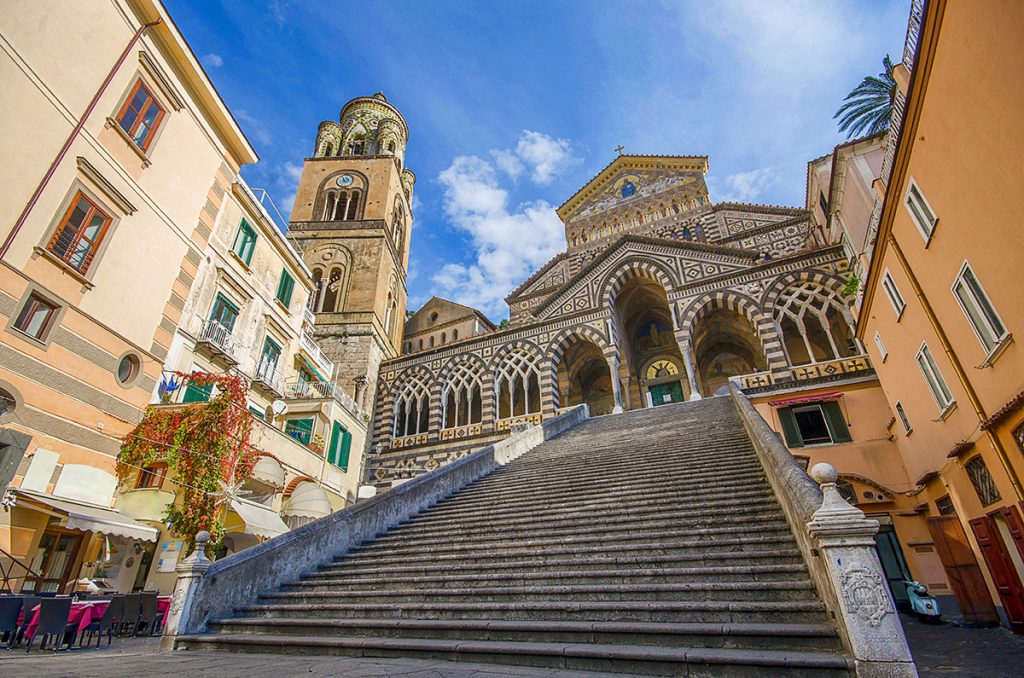
There are many destinations in the area that have become famous for their beauty and are visited by tourists all year around. One of them is the amazing Positano. Positano is a dream place, a lovely picture of houses climbing a steep slope made up of stairs and facing the bay that has become during the years one of the most popular destinations for the American jet set , VIPs and their yachts. Tourists crowd the intricate network of alleys and narrow streets, fashion trends are born here in the many renowned tailor’s shops and from Positano’s narrow handkerchiefs of lands quality produce is cultivated. The hard work of man merged with nature contributes to make the landscape fascinating but also offers distinctive citrus products like the famous Amalfi’s “sfusati”, lemons and cedars that make a fine show even on the steepest slopes.
Praiano is just less than twenty minutes away from Positano, its beautiful church of San Gennaro decorated with its majolica dome is worth a visit, its main beaches are Marina di Praia, Gavitella beach and delle Praie beach, the latter can be reached just by boat. If on a map you keep moving east from Praiano you will find one of the most picturesque seaside villages of the entire coast, the village of “Furore” which lies at the bottom of the homonymous “Fiord”, a narrow and steep valley. The Fiord can be admired from a bridge on the main road, the small Fuore is enchanting with its colorful houses and its tiny beach and owes its fame also to a very famous couple of movie stars and their troubled love story, Anna Magnani and Roberto Rossellini.
Caves are the predominant element of this area, rich in concretion rocks. The evocative “Emerald Cave” in Conca dei Marini is a must-see stop, it owes its fame to the reflections and the chromatic variations that the sunlight, entering through a submerged opening created by the water. A landing stage takes visitors to the discovery of this fascinating cavity.
From the Emerald Cave proceeding eastward on your imaginary map you will arrive in Amalfi, the first and most important Italian Maritime Republic. Its visit can only start from the “Arsenals’ where the famous galleys were built and whose boats were destined to the rich trade with the East and then progress towards the Cathedral dedicated to Saint Andrew where the remains of the apostle are kept in the crypt. This church dominates the square from the top of a steep staircase; it dates back to the IX century and of Arab-Norman style. Adjacent to it the “Cloister of Paradise”stands with its Arabian influences.
Amalfi is also famous for the paper that has been produced here since the Xlll sec and to have an idea of how it was produced one can visit the old paper mills of the “Valle dei Mulini” while the techniques of processing are illustrated in the beautiful Museum of Paper. After these stops, an ideal break may be at the Pansa pastry shop to taste the typical sweets: the lemon delight, the sfogliata Santa Rosa, and for the most refined palates the “cuoppo” of fried fish.
Situated on the hinterland of this part of the Amalfi Coast, Ravello is a destination not to be missed. The village overlooks the coast on a large terrace and in its main square the enchanting Cathedral of the eleventh century stands, inside there is a remarkable mosaic ambon and a pulpit. Ravello’s medieval residences are amongst its renowned must-see sites: Villa Rufolo and Villa Cimbrone. The first, Villa Rufolo, is located in the center of Ravello’s main square, an arabesque door leads to a tree-lined avenue, followed by Arab-Norman towers and a magnificent garden that in 1880 inspired Wagner the main act of the opera Parsifal. Nowadays the Wagner festival takes place there. The second, Villa Cimbrone, is known for the “Terrace of Infinity” overlooking its cliff. From the nearby staircase the hiking trails that take through the “Valley of Ferriere” start: they are amongst the most beautiful itineraries of the park included in the State Natural Reserve Valle delle Ferriere.
From Ravello’s state road to the east coast the harsh landscape overlooking the sea is made of high limestone walls, ravines and cliffs. Here the slopes are characterized by terraces straightened by the “macerine” or dry stone walls and the road will take you to Cetara. Laying in a bay, the fishing village of Cetara is famous for the “Colatura” of anchovies (anchovy drippings). The anchovies here are the specialty and their liquid is preserved in salt and everything is stored in traditional pottery jars, an excellent seasoning for a pasta dish.
By now the coast draws to a close and we arrive in the capital of ceramics, “Vietri sul mare”. The town is popular for the production of ceramics, a tradition that dates back to the seventh century. a.C. The emblematic and original building recalling this tradition is the factory Solimene, whose walls are made of high cones covered with ceramic tiles alternated with high windows. Here the different stages of processing ceramics take place, from modeling clay to decoration and cooking.
Thus this immersive and fabolous tour of the Amalfi Coast ends but you can just start to prepare yourself to come in person and see one the most beautiful coasts in the world.
Villa Rufolo
The access of this Villa is from the Torre Maggiore, the tower that is not far from the Dome of Ravello and has a magic door that leads you to the discovery of the incredible terraced gardens of Villa Rufolo. The Rufolos were a powerful and rich family of 1300, that had this Arab – Norman style villa erected, but it was the Scottish Francis Neville Reid that later shaped the beautiful gardens which charmed even the composer Wagner. As all places around Amalfi, it is all about the view and Villa Rufolo just delivers. The visit is recommended when the gardens are in bloom and the exotic plants that were the pride of the botanical owner give their best impression, while the insides of the villa have different ambiences and are adorned in multicolored decoration. Today the major tower has been turned into a vertical museum, while the villa is open not only to visitors but to concerts as well.
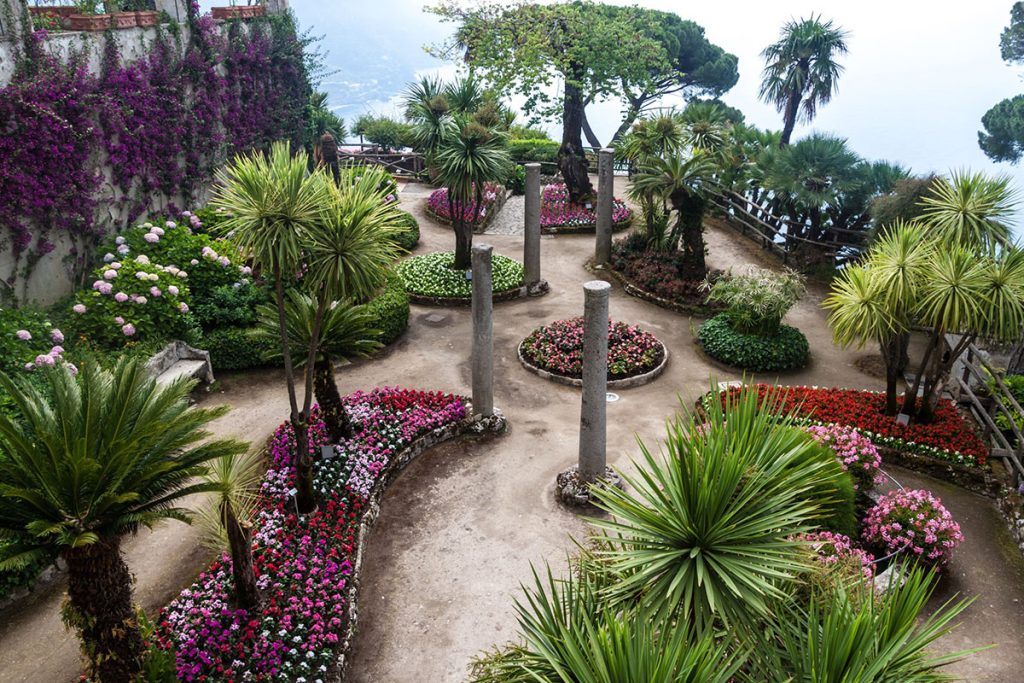
Villa Cimbrone
The name of the villa is taken from the cliff on which it stands. Today it has been turned into a hotel but its gardens are open to visitors. The palazzo has been passed from noble family to noble family while the gardens are one of the most seen locations of Ravello.Once entered in this botanical paradise, you can just stroll for hours as it is quite spacious and you will keep finding nice corners everywhere, sometimes decorated with classical statues, sometimes with grottos. The best view you can get is from the Terrace of Infinity that will offer you the coast in its greatness and beauty and the highs of your location will just make you dizzy. Roses, palms, wisteria, lilies, pergolas and classical busts will complete the incredible experience of being in a magical setting.
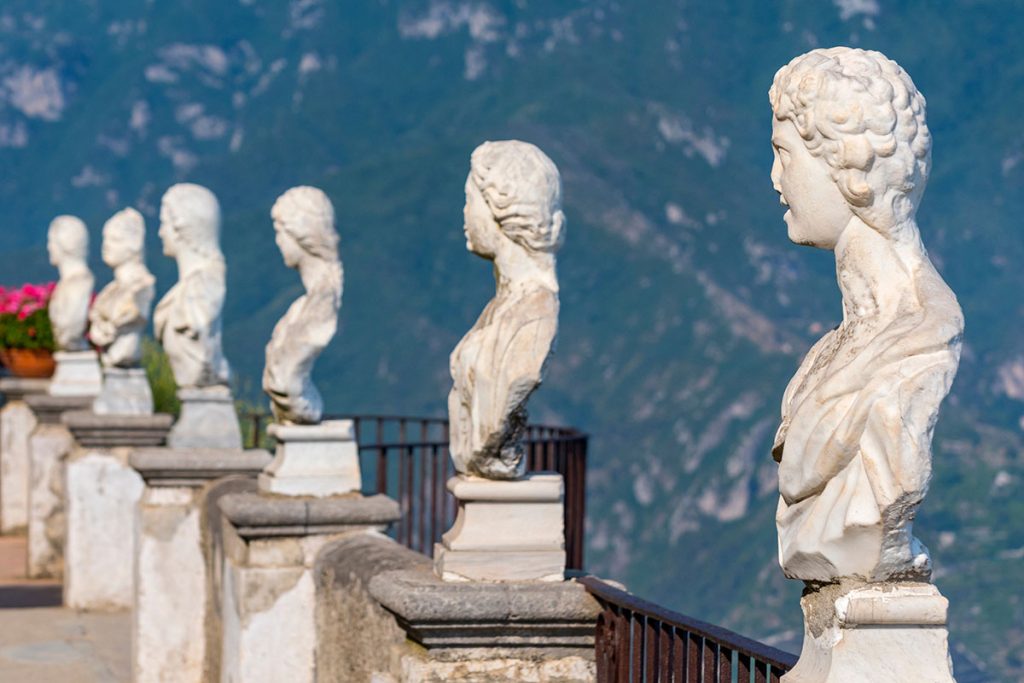
Hi, I am Anna! I made my love for art my profession and started in school, getting a degree in Conservation of Cultural Heritage. To date I have been working as a tour guide for about twenty years and I love my profession. I am a licensed guide for the region of Italy I love, Campania, and I am lucky because wherever I go there is so much to visit and discover. With every tour I put all my professionalism, passion and most of all my energy and smile. If you are thinking of visiting Naples, Amalfi, Capri and all the other fantastic locations that the Campania region has in store, give me a call, I will be happy to suggest next to the classic itineraries, also more suggestive, secret and unexplored corners that you will love. I organize visits, including to cooking and handicraft workshops, and I also take care of organizing preparation lessons in classrooms or museums , gastronomic itineraries, trekking, and much more, from group to private tours. My experience in the field of tourism is extensive and also includes organizing educational tours or simply giving free suggestions to accompany anyone who wants to visit these fantastic places.
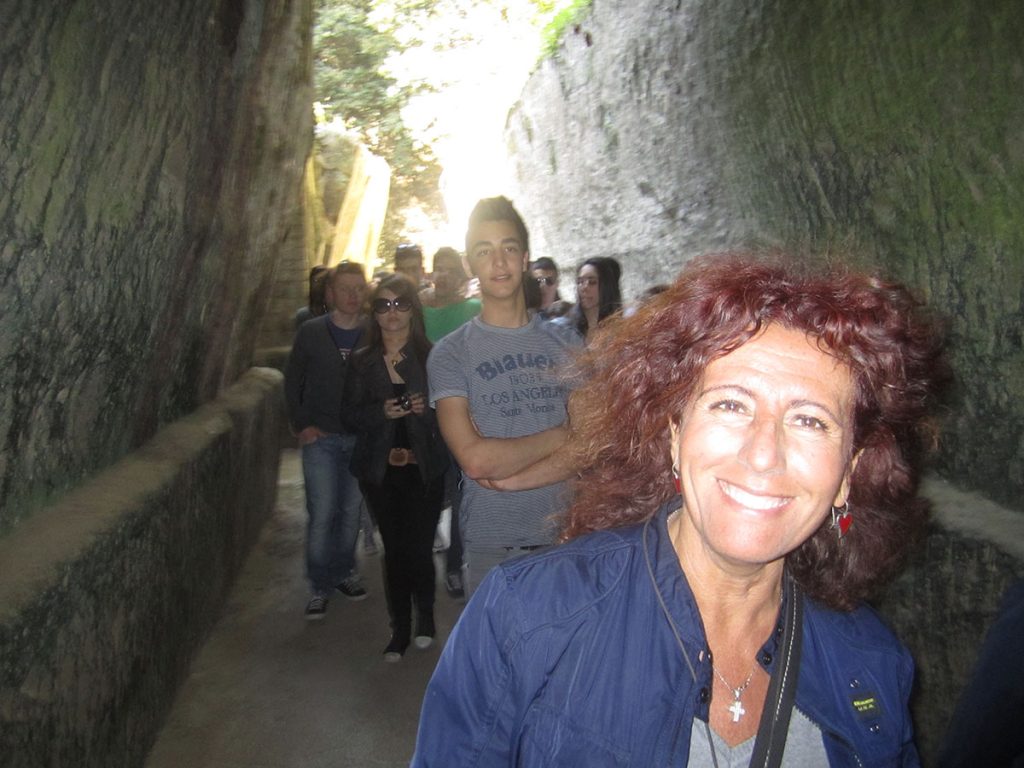
Your smile and satisfaction are my boost! I am waiting for you! Anna